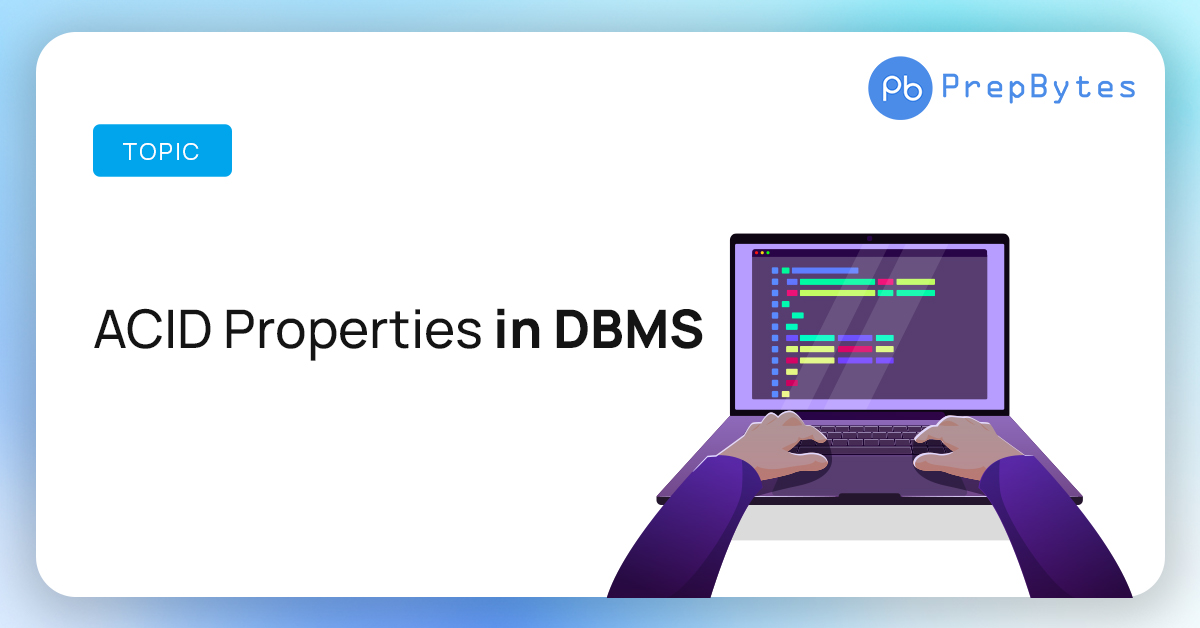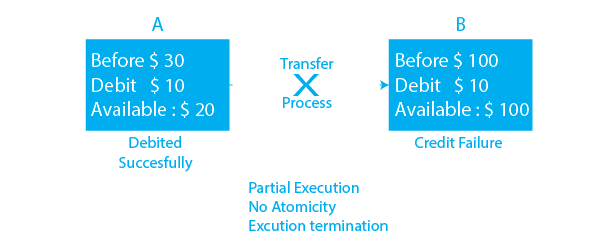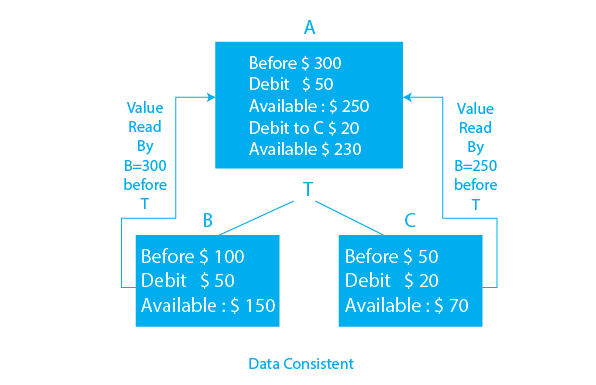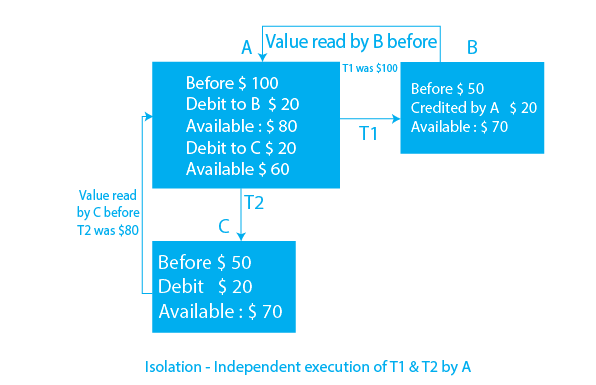Last Updated on November 30, 2023 by Ankit Kochar

In the realm of databases, the ACID properties play a pivotal role in ensuring the reliability, consistency, and integrity of data. ACID stands for Atomicity, Consistency, Isolation, and Durability, forming the cornerstone principles that govern the transactions within a database management system (DBMS). These properties are fundamental in maintaining data accuracy and reliability, especially in scenarios where multiple transactions occur concurrently. Understanding the significance of ACID properties is essential for database administrators, developers, and anyone involved in managing or utilizing databases. This article delves into a comprehensive exploration of ACID properties in DBMS, shedding light on their individual components, their importance, and their impact on ensuring robust data management.
What is Database Transaction?
A logical unit of work known as a "transaction" accesses and modifies a database’s data. Transactions access data via read-and-write operations. An exchange can be in multiple states:

- Active State: Every transaction starts out in the active state. The transaction is currently being carried out in this state
- Partially Committed State: A transaction has reached this state when it completes all operations but the data has not been saved to the database
- Failed State: The transaction is considered to be in the failed state if any of the database recovery system’s checks fail
- Committed State: If a transaction completes its final operation successfully, it is considered to be committed. In this state, all of the changes are written to memory and as a result, saved on the database system permanently
- Aborted State: If any of the tests fail, the transaction is said to go to a failed state. Upon entering this state, the database recovery system attempts to bring the database to the previous consistent state(committed state). If this doesn’t happen then the transaction would be rolled back or aborted so as to bring the database back to a consistent state. Once it has been aborted, the database recovery module will either kill the transaction or re-start the transaction
- Terminated State: If there is no rollback and the transaction is in the “committed state,” the system is consistent and ready for a new transaction, while the old one is terminated
As modifications are made to a database, the administration of that data should continue to be integrated. The reason for this is because if the data’s integrity is compromised, the entire set of data will be disrupted and damaged. As a result, the database management system describes four qualities known as the ACID properties in order to ensure the integrity of the data. The transaction that goes through a separate set of duties is where we get to understand the purpose of the ACID attributes.
In this section, we will learn and understand the ACID properties. We will learn what these properties stand for and what each property is used for. We will also understand the ACID properties with the help of some examples.
ACID Properties in DBMS
The definition of ACID in its expanded form is:

1) Atomicity
The concept of atomicity refers to how atomic the material stays. It indicates that if any operation is conducted on the data, it should be done fully, partially, or not at all. It also implies that the process shouldn’t stop midway through or only partly complete. When performing actions on a transaction, the operation should be carried out entirely, not just partly.
Example of Atomicity:
Suppose Remo wants to transfer $10 to Sheero’s account, B, from account A, which has $30 in it. A hundred dollar amount is already extant in account B. $10 will become $110 when it is moved to account B. Two procedures are going to happen right now. One is that the $10 Remo wishes to move will be deducted from account A and credited to account B, or Sheero’s account, in the same amount. What occurs next is that the initial debit operation completes properly, but the subsequent credit operation does not. Thus, in Remo’s account A, the value becomes $20, and in that of Sheero’s account, it remains $100 as it was previously present.

As seen in the above illustration, $100 is still in account B after $10 has been credited. The deal is not instantaneous, therefore.
The image below demonstrates that effective debit and credit procedures have been carried out. The deal is therefore instantaneous.

Therefore, atomicity is the primary emphasis in the bank systems because when the amount lacks atomicity, this causes a big problem.
2) Consistency
Consistency implies that worth should always be maintained. In DBMS, the security of the data must be upheld, which calls for any changes to the database to always be kept. Data security is crucial in transactions because it ensures that the database is consistent both before and after the transaction. The information should always be accurate.
Example of Consistency:

Three accounts—A, B, and C—are shown in the above diagram, and A is depicted sending transactions T to both B and C one at a time. Debit and Credit are the two processes that are carried out. Account A first debits account B by $50, and before the transaction, account B reads $300 in account A. Following the completion of deal T, $150 is now accessible in B. Now, A debits $20 to account C, and C reads that amount as $250 (which is accurate because A correctly debited $50 from B). Successful completion of the transfer and credit transaction from account A to account C. The deal appears to have been completed effectively, and the value has also been accurately read. The evidence is uniform as a result. If the number read by B and C is $300, the data is incongruous because it will not be consistent when the debit procedure is carried out.
3) Isolation
Isolation is another word for seclusion. Separation in DBMS refers to a database’s ability to operate simultaneously while ensuring that no data should impact the other. In other words, when an action on one database is finished, an operation on another database should start. It implies that two actions on two separate databases may not have an impact on one another’s worth. The uniformity should be upheld when two or more deals take place at once in the case of transactions. Other transactions won’t notice any modifications made during a specific transaction until the change has been saved to memory.
Example of Isolation: The value of both accounts shouldn’t change if two tasks are being performed simultaneously on two separate accounts. The worth ought to continue to exist. As shown in the picture below, account A is making T1 and T2 transfers to accounts B and C, but both are carrying them out separately and without interfering with one another. It is referred to as isolation.

4) Durability
Something is permanent if it is durable. Durability in DBMS refers to the guarantee that data remains in the database permanently after an action has been successfully completed. Data should be so perfectly durable that it can still function even in the event of a system failure or breakdown. However, if it disappears, the recovery manager is now in charge of making sure the database is durable. Every time we make adjustments, we must use the COMMIT command to commit the numbers.
As a result, the DBMS’s ACID characteristic is crucial for ensuring the integrity and availability of data in the database.
As a result, the ACID characteristics were precisely introduced to DBMS. These assets have also been covered in the transaction part.
Conclusion
In conclusion, the ACID properties in DBMS serve as a vital framework for ensuring the integrity and reliability of data within databases. Atomicity ensures transactions either complete in full or not at all, Consistency maintains the database in a valid state, Isolation ensures concurrent transactions don’t interfere with each other, and Durability guarantees that committed transactions persist even in the event of system failures. These properties collectively form the backbone of dependable and secure database systems, contributing significantly to data integrity and reliability. As technology advances and the volume of data continues to grow, understanding and implementing ACID properties remain crucial for building robust and efficient database management systems.
FAQs Related to ACID Properties in DBMSFAQs Related to ACID Properties in DBMS
Here are some FAQs related to ACID Properties in DBMS.
1. What is the significance of ACID properties in DBMS?
ACID properties ensure that database transactions are reliable, consistent, isolated from one another, and durable, thereby maintaining data integrity and reliability.
2. How does Atomicity contribute to ACID properties?
Atomicity ensures that either all operations within a transaction are completed successfully, or none of them are. This property helps prevent incomplete transactions that could compromise data integrity.
3. What role does Consistency play in ACID properties?
Consistency guarantees that the database remains in a valid state before and after any transaction. It ensures that constraints, rules, and relationships are maintained, preventing data corruption.
4. What does Isolation mean in the context of ACID properties?
Isolation ensures that the execution of concurrent transactions does not interfere with each other. It prevents one transaction from accessing data that another transaction is currently modifying.
5. How does Durability contribute to ACID properties?
Durability ensures that once a transaction is committed, its changes are permanently saved even in the face of system failures, such as power outages or crashes, thereby maintaining data persistence.
6. Are there any trade-offs associated with maintaining ACID properties?
While ACID properties provide robustness to databases, ensuring all four properties simultaneously might impact system performance, especially in highly concurrent environments. Achieving a balance between ensuring ACID compliance and performance is essential.


